Learning fast touch typing

High speed typing is a skill that will come in handy at school, university, for working at home and in the office.
Why is it necessary to type quickly?
The ability to type quickly on a computer keyboard is an extremely valuable professional skill in the modern world.
The ability to type quickly texts of any complexity, without looking at the keyboard, is necessary for everyone working on a computer - this increases productivity, saves time, reduces body fatigue: the load on the nervous system is reduced by 20%.
In the vacancies associated with working on a computer, increasingly, employers indicate proficiency of fast touch typing skill in the basic requirements for job seekers.
How to learn to type faster?
Nowadays many people master the skill of high-speed typing by themselves. Anyone can learn how to type texts on a computer quickly using the correct typing technique in combination with regular workouts.
-
Mastering the ten-finger touch typing method. The main secret of fast typing is the skill of typing without looking at the keyboard (blindly), using all fingers.
-
Regular exercises on a typing trainer. People who use the ten-finger touch typing method are recommended to hone the fast typing skill on a typing trainer, which makes it possible to work out typing problematic letter combinations.
-
Ergonomic keyboard. Use a special ergonomically shaped keyboard to increase typing speed and reduce the number of typos.
-
Correct sitting posture at the computer desk. The correct position of the body when working at the computer evenly distributes the load throughout the whole body, which avoids muscle strain, contributes to better blood flow and breathing.
-
Wrist exercises. Strengthen the wrists so that during long typing the muscles of the hands less often get tired, which will give a gain in typing speed.
Ten-finger touch typing method
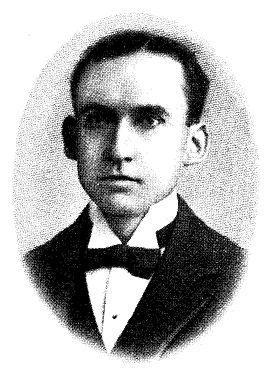
The touch typing method appeared in America at the end of the 18th century. About 130 years ago, the stenographer Frank Edward McGurrin developed for himself a special technique for ten-finger typing on a typewriter. Later, the touch typing technique also became known as typewriting. In the 20th century, ten-finger touch typing successfully adapted to a computer keyboard.
Touch typing is based directly on the formation of muscle memory and tactile sensations, where the main goal is to study and bring up the movements of fingers to automatism, and as a result, remember (with fingers) the location of the keys on a particular keyboard layout.
The ten-finger typing method assumes that a strictly defined keyboard area is assigned to each finger. Each finger has to make some movements of the same type, since it moves only in the keyboard areas specified for it. During typing, finger movements occur at a subconscious level, without focusing on the typing process. This is the principle of the ten-finger typing method.
After bringing the ten-finger typing skill to a high degree of automatism, typing speed will increase significantly. Only the coordinated work of all 10 fingers during typing will enable you to achieve the highest typing speed.
A person can independently learn the ten-finger touch typing technique, practicing, following the basic methodological principles. But it’s much more efficient to take advantage of specially designed typewriting courses.
On average, given daily lessons, fast-typing learning takes less than 1 month, if you devote 1.5-2 hours to training. Of course, the more diligent a student and the more regular classes, the faster you can master the ten-finger touch typing method.
In the vast majority of cases, proper learning the ten-finger touch typing method makes it possible to type without looking at the keyboard, quickly and accurately.
The acquired skill remains with the person for the rest of his life, and saves not only time while working at a computer keyboard, but also maintains health.
Start learning ten-finger touch typing – make a useful contribution to your future!
Proper sitting posture at a computer
People often neglect the principles and requirements of ergonomics. However, the organization of the workplace makes it easier to work on the computer.
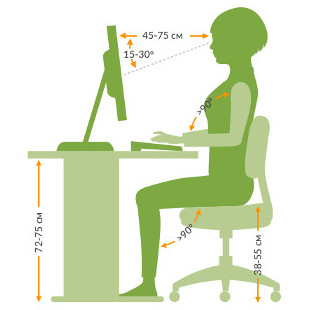
There should be a straight back, a head without tilting. The optimum distance to the screen is 45-75 cm. The gaze is fixed on the center of the monitor.
The angle at the elbows and knees should be 90°, or a little more.
Feet should be flat on the floor.
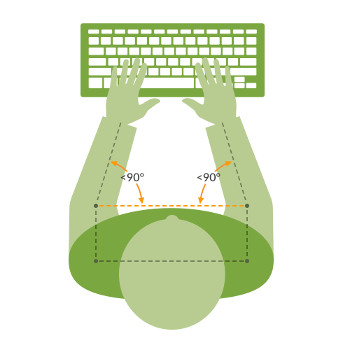
The shoulders are parallel to the body. Elbows should not protrude over the edge of the desk.
The forearms are naturally reduced to the base of the keyboard and each one forms an angle of slightly less than 90°.
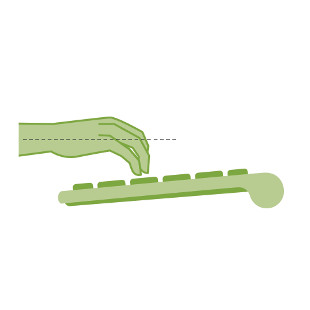
The fingers are slightly touching the keys. The palms are relaxed, as if holding a small round object.
The wrists are parallel to the work surface and should not sag.
The initial hands position on the keyboard.
ASDF и JKL; – re two "magic words" that will help anyone to quickly learn how to type on a computer. The keys with these letters are in the middle (the home row) of the keyboard.
On the way to fast typing, 50% of success depends on the correct hands placement on the keyboard, on how accurately you can put your fingers to the initial position, on the ability, without looking at the keyboard, to find the initial position, feel and sense the keyboard.
According to the diagram below, put the left hand fingers on the four side letters of the keyboard home row – ASDF, the right hand fingers – JKL;. Thumbs automatically rise above the spacebar. This is the initial position of the hands on the keyboard.
Left hand
- pinky finger — A
- ring finger — S
- middle finger — D
- index finger — F
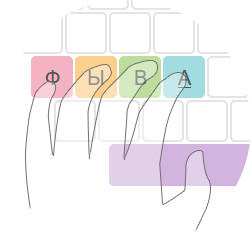
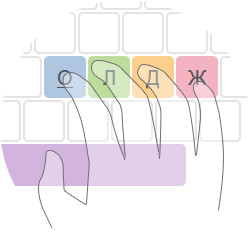
Right hand
- J — index finger
- K — middle finger
- L — ring finger
- ; — pinky finger
Under the index fingers on the keys with the letters F and J there are small raised dots (bumps), thanks to them, the hands quickly find and take the starting position on the keyboard.
Keyboard Finger Areas
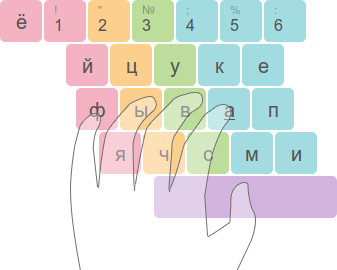
During ten-finger typing, each finger is assigned a certain group of keys on the keyboard.
The color scheme in the figure reflects one of the options for the location of such areas. There are several kinds of grouping the keys according to the fingers.
When typing a text, be sure to use only the appropriate fingers to press the keys.
When typing a text, the hands actually do not move - only fingers move.
If the next letter is in a different keyboard area and the corresponding key is supposed to be pressed with another finger, the finger you’re using at that moment must necessarily return to its starting position with the letters ASDF and JKL;, after pressing the key.
Do not peek at the keyboard - the text is typed only blindly. The eyes are concentrated on the screen, or on the source text.
Ring fingers and pinky fingers are much less developed than the other ones, so more zeal is needed to train them.
The spacebar is pressed with a thumb of a hand that isn’t in use at that moment. If you typed the last letter before the space with your left hand, then the spacebar is pressed with the thumb of your right hand, and vice versa - if the last letter is typed with your right hand, then the spacebar is pressed with the thumb of your left hand.
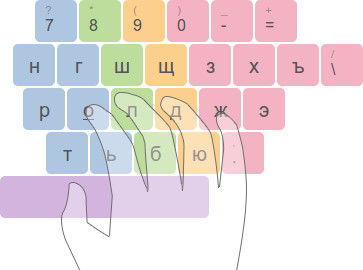
Touch Typing Tutor
Fast typing speed is developed through daily practice, but it is much more effective to exercise typing training on a special typing tutor. Such trainers are designed for people who can type using ten-finger touch method.
Touch typing tutor for high-speed typing development is based on the following principle: during typing user’s typos are fixed, based on them subsequent portions of the text with problem words or letter combinations are generated.
Sign up, to get paid access to our training portal, where lots of features are available, like a large number of texts for testing typing speed, a typing trainer for increasing typing speed and an interactive course for learning ten-finger touch typing.
Typing faster with an ergonomic keyboard
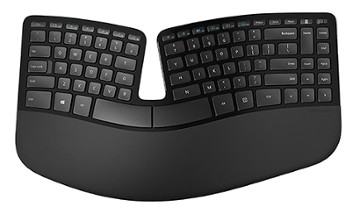
A regular keyboard does not enable you to type large texts comfortably. Fingers and hands get tired quickly, which leads to a gradual decrease in typing speed and, as a result, to a deterioration in quality (an increase in the number of typos).
An ergonomic (split) keyboard solves this problem. According to studies, the use of an ergonomic keyboard can reduce hand fatigability and finger fatigue by about 20%, increase typing speed by 15% and reduce the number of typos by 30%.
The ergonomic keyboard has a curved shape. Custom keyboard layout, wrist rest and other tricks provide convenient and quick typing.
Such a keyboard is indispensable for people who have mastered the ten-finger touch typing skill.
Wrists workout for quick typing
Various hands muscles are involved during typing. Fatigue is characteristic of any muscles, and fingers are no exception. The brain sends the hands a signal to press one or another key, and the fingers do not obey. Fingers are tired and want to relax! Hence the decrease in speed and errors come - due to fatigue.
To maintain high typing speed during long typing, you need to pay attention to endurance and muscle tone. Do physical exercises that will not only help strengthen hands muscles, but also will prevent the appearance of tunnel syndrome and arthritis:
Squeeze your hands into fists for 3-5 seconds, then slowly unclench, widely spreading your fingers. (10 times for each hand)
With clenched fists, rotate your wrists clockwise and counterclockwise. (10 times each way)
Alternately rotate each finger clockwise and counterclockwise. (10 times for each finger)
Put your palms together and alternately spread and join paired fingers. (5 movements with each pair of fingers)
Alternately connect the thumb pad to the fingertips of all other fingers. (5 times for each hand)
Massage the inside of the palms in a circular motion clockwise, gently pushing the thumb on the palm of the other hand. Then massage all the fingers, starting with the little finger, from the base of the finger to the top and back.
Squeeze-unclench the carpal expander alternately with each hand.
Spin the gyroscope trainer with each hand for several minutes a day.
Various pull-ups on the horizontal bar and hanging on it will improve the endurance of hands and forearms muscles.





